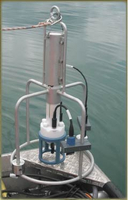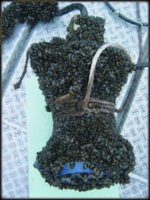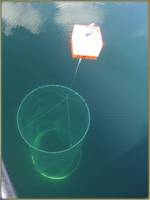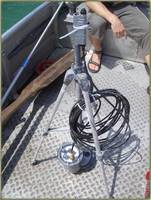Experimental physical limnology
Mixing and transport processes are investigated using natural tracers, transient tracer techniques and methods based on turbulence measurements. In lakes the spatial distribution and the temporal variation of temperature, conductivity and suspended particles are not only relevant as indicators of transport processes but also determine the density stratification. The density distribution is required for the understanding of convective transport processes, vertical turbulent mixing and internal wave motion in lakes. Besides CTD-profiling we also install moorings with high resolution temperature sensors to investigate internal waves. With a multi-probe we also measure the distributions of dissolved oxygen, chlorophyll a and pH which provide additional information on exchange processes, because the distributions of these tracers show natural gradients due to bio-geochemical processes. Furthermore, these properties are also important in ecosystem functioning and thus constitute an important link between physical and biological studies of lake ecosystems. Besides the traditional tracers other natural water constituents such as tritium, noble gases, CFC´s, SF6 and methane are employed to investigate exchange processes in aquatic systems (cooperation with colleagues at ETH-Zurich/EAWAG). Large scale circulation is investigated by deployment of floats that follow the mean current and thus mark the track of water parcels. Surface waves are investigated base on moored pressure sensors and current meters. The impact of surface waves on the littoral ecosystem is investigated using turbidity meters, a chain of PAR sensors, sediment traps and water sampling.
A methodological focus of our research group is the application of Acoustic Doppler Current Meters (ADCP, ADV) for different questions in aquatic research. ADCP and ADV not only allow to measure current profiles (ADCP), but can also be used to measure the level of turbulence or to directly measure the turbulent flux of tracers. In one of our projects the latter technique is currently implemented for long-term field measurements. ADCP and ADV additionally provide information on particles in the water column via the backscattering strength of the acoustic signal. We use this information to investigate the spread of suspended particles and the distribution and vertical movement of zooplankton.
Instruments
- CTD and mulit-parameter probe (temperature, conductivity, pressure, turbidity, fluorescence, oxygen, pH)
- ADCPs, ADVs, Aanderaa current meters
- Thermistor chains and temperature loggers
- Temperature microstructure probe
- Chain of par sensors
- High-resolution pressure sensors (measurements of surface waves)
- Autonomous drifters
- Water-, sediment and plankton sampling
Modelling approach
Different types of model are required to investigate the physical processes studied in our research group. In cooperation with the IOW a 3-dimensional hydrodynamic model will applied to Lake Constance. A refined grid in the boundary layer will allow refined simulations intended to support the interpretation of detailed experimental investigations. The analysis of large scale oscillations in lakes (seiches, oscillations of bays and topographic waves) results in eigen-value problems that are solved numerically in cooperation with Dr. Erich Bäuerle. The wind induced wave field and the properties of surface waves propagating into the littoral zone are simulated by the wave models SWAN und FUNWAVE.
In addition we develop own ecosystem models which combine mixing dynamics with bio-geochemical processes. These models are employed to investigate the role of physical processes for the temporal dynamics in aquatic ecosystems. The aim of the ecosystem modelling is a better understanding and parameterization of the biological and chemical processes in highly variable environmental conditions. The ecosystem models are only 1-dimensional which makes possible long-term simulations and thus enables the study of the response of aquatic ecosystems to long-term changes in environmental forcing (e.g. climate change, oligotrophication).





